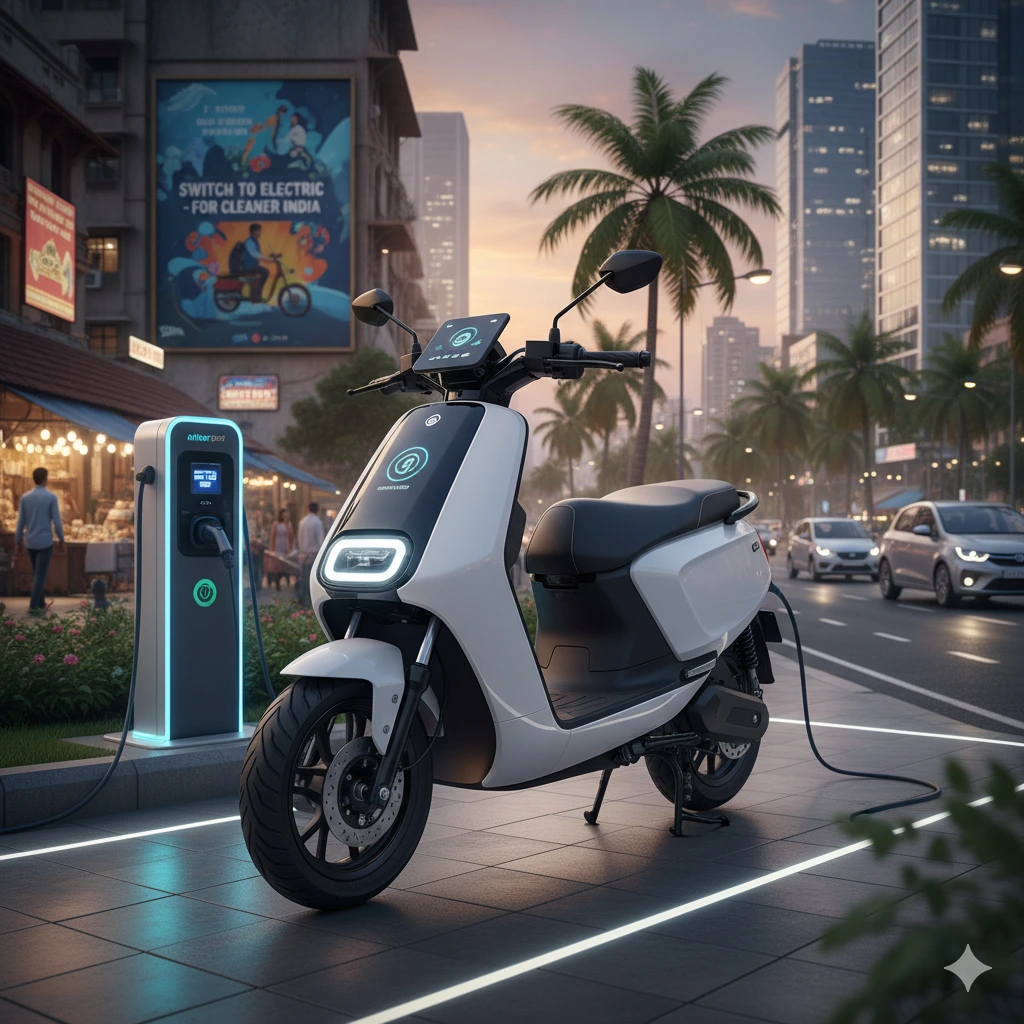India’s Electric Two-Wheeler Boom: Consumer Trends, Key Players, and Growth Strategies

Electric two-wheelers are transforming the transportation landscape in India. Once a niche, the segment has now entered the mainstream, driven by a combination of policy support, technological innovation, and enthusiastic consumer uptake. In 2024 alone, India sold over 1.15 million electric two-wheelers – a 33% jump from the previous year – underscoring that these battery-powered scooters and bikes are no longer outliers but a central part of India’s EV revolution. This deep-dive explores the current state of India’s EV two-wheeler market (focused on B2C consumers), the factors fueling its growth, the challenges ahead, and how companies (and growth enablers like GrowthJockey) are navigating this exciting journey.
India’s EV Two-Wheeler Market: An Overview
India is now the world’s second-largest electric two-wheeler market by volume (behind only China), with annual sales expected to soar from around 1 million units in 2023 to 7–9 million by 2030. Electric two-wheelers already dominate India’s EV sector: 59% of all EVs sold in 2024 were e-scooters or e-bikes (up from 56% in 2023) far outpacing electric car adoption. This momentum has been spurred by strong government backing. The FAME II subsidy program (launched 2019) and production-linked incentives jumpstarted domestic EV manufacturing, helping annual e-two-wheeler sales leap 10x from ~100,000 to ~1,000,000 within a couple of years. In September 2024, the government introduced the PM E-DRIVE Scheme with a ₹109 billion (~$1.3B) outlay to further incentivize EV purchases, electrify public transport, and expand charging infrastructure These measures – alongside tax cuts on EV imports and support for local battery production – have created a favorable environment for the electric mobility revolution in India
Crucially, India’s policy push is matched by clear consumer enthusiasm. A recent survey shows 86% of consumers in India are open to buying an electric two-wheeler in the future (versus ~62% in Europe) – a striking indication of demand. McKinsey projects that by 2030, electric two-wheelers could comprise 60–70% of all new two-wheeler sales in India, given the current trajectory. In short, India’s electric two-wheeler market is on a fast track to mass adoption, setting the stage for a cleaner and more innovative mobility future.
Why Consumers Are Embracing E-Scooters and E-Bikes
Several powerful drivers are convincing everyday consumers to switch from petrol scooters to electric ones:
-
Lower Operating Costs: Electric scooters offer dramatically cheaper running costs compared to their gasoline counterparts. For example, ₹100 worth of charge can power an Ather e-scooter for ~438 km, whereas ₹100 of petrol yields only ~40 km on a conventional scooter. Overall, the per-kilometer operating cost of an electric two-wheeler is roughly one-sixth to one-eighth that of a petrol scooter. With fuel prices high, consumers see significant savings in daily commuting costs. Maintenance expenses are also lower (no oil changes, fewer moving parts), making total cost of ownership very attractive over a few years.
-
Government Incentives & Subsidies: Buyers can take advantage of central and state EV subsidies, tax breaks, and road-tax exemptions that reduce the upfront price gap. Many Indian states offer additional incentives on electric two-wheelers (like direct subsidies or waiver of registration fees), making EV models more price-competitive with petrol models. These incentives, combined with innovative financing schemes (low-interest loans, battery leasing, etc.), are lowering the barrier to entry for consumers
-
Eco-Friendly Appeal: Environmentally conscious millennials and Gen Z riders are drawn to the zero tailpipe emissions of EVs. Electric two-wheelers promise cleaner air and reduced carbon footprint – a key selling point as awareness of climate change and urban pollution grows. Even when accounting for India’s coal-heavy electricity, studies find EVs emit at least 35% less CO₂ than equivalent petrol vehicles, and up to 85% less if charged from renewable energyOwning an e-scooter is seen as a tangible way to contribute to sustainability.
-
Improving Performance & Features: Modern electric two-wheelers have shed the image of being underpowered. Today’s e-scooters can easily hit speeds of 70–100 km/h, with instant torque that often beats petrol bikes off the lineModels like the Ather 450X come with high-tech features – from touchscreen dashboards with navigation to smartphone connectivity and even “Warp” acceleration modes– offering a futuristic ride experience. The blend of performance and smart features is enticing tech-savvy Indian consumers looking for an upgrade from traditional scooters.
-
Urban Convenience: For city commuters, electric two-wheelers check many boxes: they are virtually silent, reduce traffic noise, and often enjoy perks like green number plates (which in some cities come with parking or usage benefits). Many e-scooters have removable batteries that allow charging at home or office, removing the dependency on fuel stations. Given that the average urban commute is well within an e-scooter’s range (typically 50-100 km per charge), most users find electrics perfectly adequate for daily needs without any compromise in convenience.
Consumers, in summary, are finding that electric two-wheelers align with both their economic interests and lifestyle values. The “cool factor” of new technology, coupled with tangible savings and eco-benefits, has made EV two-wheelers a compelling proposition in the B2C market.
Overcoming Hurdles: Challenges in Adoption
Despite the rapid progress, certain challenges still temper the electric two-wheeler adoption curve. Both industry players and policymakers are actively addressing these pain points:
-
High Upfront Cost: Electric two-wheelers generally cost more to purchase than equivalent petrol models, largely due to expensive battery packs. This price gap can deter cost-conscious buyers, especially in the mass-market segment. Solution: Government subsidies under programs like FAME II directly discount the price, and some manufacturers offer battery leasing options to cut the upfront cost. For instance, Battery-as-a-Service (BaaS) models let customers buy an e-scooter minus the battery and subscribe to a battery plan for as low as ₹999 per month – reducing the vehicle’s upfront cost by almost 40%This innovative leasing approach, along with falling battery prices each year, is steadily closing the price gap.
-
Range Anxiety & Charging Infrastructure: Many prospective buyers worry about range limitations and the scarcity of charging points. While most e-scooters have enough range for city use, the fear of running out of charge (“range anxiety”) is a psychological barrier. Solution: The charging network in India is expanding quickly – from 10 lakh (1 million) chargers in 2022 to over 15 lakh in 2023 globally – but urban coverage still needs improvement. Companies and governments are installing more public chargers at malls, parking lots, and highways Battery swapping is another game-changer: start-ups like Sun Mobility and Battery Smart have set up swap stations where riders can exchange a depleted battery for a full one in minutes. This BaaS + Swapping model not only eliminates refueling delays but has proven particularly beneficial for high-usage riders (like delivery gig workers) by virtually ending downtime Additionally, manufacturers are assuaging range fears by providing battery warranties (e.g. 5-7 years guarantee) and incorporating smarter range prediction systems that account for weather, load, and riding style
-
Charging at Home & Work: Apartment dwellers and office-goers often face lack of charging provisions at parking spots. Unlike petrol which can be bought anywhere, EV owners need a reliable power source. Solution: Recognizing this, real estate developers and RWAs are now more frequently adding EV charging points in residential complexes. Many e-scooter models have portable battery packs that owners can simply carry home to charge using a normal wall socket – a convenient workaround requiring no special infrastructure. Power companies are also developing smart grid solutions to handle the extra load from EV charging and avoid straining local transformers
-
Consumer Awareness and Trust: Being a relatively new technology, some consumers harbor misconceptions about electric two-wheelers – whether it’s doubts about safety, battery fires, maintenance, or simply a lack of firsthand experience. Dealership sales staff in the past were sometimes ill-prepared to answer EV-specific queries. Solution: The industry has responded with massive awareness campaigns and education. Manufacturers now offer extensive test ride programs and demo events to let people experience EVs firsthand. Sales teams are being trained specifically on EV features and benefits. Companies like Ola and Ather ran referral schemes and community rides to build word-of-mouth. Moreover, highlighting real-world use cases – like delivery fleets successfully running thousands of e-scooters – has helped build confidence that the technology is road-proven. Ensuring robust after-sales service (training local mechanics, setting up service centers in smaller cities) is further boosting consumer trust that maintenance and repairs won’t be a bottleneck.
-
Battery Life and Safety: High-profile incidents of battery fires in early models raised concerns about EV safety. Also, consumers often ask how long the battery will last and what replacement costs might be. Solution: EV brands have put safety front and center. Reputable players use advanced battery management systems, thermal safeguards, and rigorous testing to meet stringent safety standards (a point stressed by Suzuki when launching its e-scooter in India: battery safety and long life are top design priorities). Companies now commonly provide 5-year or 60,000 km warranties on batteries to assure buyers of longevity. Recycling and buy-back programs are emerging to handle end-of-life batteries sustainably. These efforts collectively are shifting the perception – new surveys indicate today’s buyers are far less concerned about safety than they were two years ago as EVs prove themselves on the road.
In summary, while hurdles like cost, infrastructure, and awareness remain, the solutions are well underway. Continuous innovation – be it in business models (leasing/swapping), technology (better batteries), or policy (subsidies, mandates) – is rapidly smoothing out these bumps, paving the way for even faster adoption in the coming years.
Competitive Landscape: Start-ups vs. Legacy Brands Shaping the Market
India’s EV surge is a story of both new-age start-ups and established automakers. The chart above shows the explosive growth of leading electric two-wheeler brands from 2022 to 2024 (units sold), based on registration data. It’s clear that start-ups have catalyzed the market – for instance, Ola Electric went from essentially zero sales in 2021 to dominating with 35% market share in 2024. selling roughly 3.9 lakh electric scooters that year. Ola’s aggressive marketing, affordable pricing, and direct-to-consumer sales model (along with high-profile product launches like the S1 scooter) helped it quickly capture leadership. Another Bengaluru-based start-up, Ather Energy, pioneered the premium e-scooter segment and held about 11% share in 2024. Ather is known for its technology-centric approach – offering features like fast charging and a slick touchscreen interface – and for building an ecosystem of fast-charging stations (Ather Grid) to support its customers. These new players proved that consumer demand exists at scale, effectively “creating the market” for EV two-wheelers in India.
At the same time, legacy two-wheeler manufacturers have rapidly woken up and risen to the challenge. For instance, TVS Motor Company (maker of the iQube electric scooter) captured ~19% of the EV scooter market in 2024, nearly the same share as in the prior year – indicating it successfully defended its turf by scaling up EV production. Bajaj Auto, another household name, made a big splash with its Chetak electric scooter. Bajaj’s EV sales rocketed from about 72k units in 2023 to 1.93 lakh units in 2024, doubling its market share to ~17%. In fact, Bajaj’s electric division turned profitable in 2024, and the company has announced strong commitment to expand its EV portfolio going This is a remarkable turnaround for a traditional OEM and signals that incumbents can compete head-on with start-ups once they commit to the new tech.
Other notable players include Hero MotoCorp (which launched its Vida electric scooter and also backs Ather as an investor) and Greaves Electric Mobility (Ampere brand), each carving out smaller but growing slices of the pie. Meanwhile, new entrants keep coming: in late 2024, Suzuki unveiled its first e-scooter for India, emphasizing it has addressed consumer pain points like safety and battery life in its desig. Dozens of other startups and even automotive outsiders have tried their luck in this booming space, though many will consolidate or partner as competition intensifies.
What’s fascinating is how both start-ups and incumbents are adopting each other’s playbooks. Start-ups like Ola are now setting up extensive physical experience centers (expanding from 800 to 3,200 outlets in a year) to reach more consumers beyond online channels. On the other hand, established companies are innovating more like start-ups – for example, TVS and Bajaj aggressively iterating on EV models, and legacy dealers learning digital marketing tactics to engage younger buyers. All the major players are also investing in building out charging or swapping networks, mobile apps, and unique services (recall that “winning brands design entire ecosystems” with dedicated charging solutions and apps to stand out). This convergence means the end consumer now has a rich variety of choices and a progressively improving ownership experience.
The net result is a highly competitive yet collaborative ecosystem. The top four brands (Ola, TVS, Bajaj, Ather) together accounted for over 80% of e-two-wheeler sales in 2024, indicating a trend toward consolidation at the top. However, the race is far from settled – each month brings shifts in rankings (for instance, one month Ather leapfrogs Ola in sales, another month a newcomer launches a hit model). Ultimately, this competition is great news for consumers: it’s driving rapid improvements in product quality, feature offerings, and price affordability. Electric two-wheelers in India are truly a battleground of innovation now, with both scrappy start-ups and seasoned manufacturers pushing each other to charge ahead.
The Road Ahead and GrowthJockey’s Role in the EV Revolution
Going forward, the trajectory of electric two-wheelers in India looks exceedingly bright. Analysts predict an inflection point where annual EV two-wheeler sales could hit 7–9 million by 2030– meaning the majority of new two-wheelers sold will be electric. If current growth rates sustain (over 30–40% year-on-year), India may even exceed its target of 30% of all personal vehicle sales being electric by 2030. Key trends to watch include the rollout of better batteries (higher range, faster charging), expansion of charging infrastructure into smaller towns, and perhaps most critically, the decline in EV prices as scale economies kick in. Many in the industry expect that within the next 2-3 years, an electric scooter will cost the same upfront as a comparable petrol scooter, eliminating the final barrier to mass adoption. Additionally, as consumers experience the benefits (and resale markets for used EVs develop), the second-hand market will grow, further driving popularity. In essence, India’s electric two-wheeler journey is set to shift into higher gear, bolstered by supportive policy, enthusiastic consumers, and relentless innovation.
Amid this rapid evolution, companies will need savvy strategies to capitalize on the opportunity. This is where partners like GrowthJockey come into play. GrowthJockey is an India-based venture architect and growth consulting firm that specializes in the EV and automotive domain, helping businesses ride the electric mobility wave. “Our expertise spans electric scooters, e-rickshaws and beyond – and we’re committed to supporting businesses and consumers in this exciting journey,” notes GrowthJockey in its EV industry outlook In practical terms, GrowthJockey provides data-driven growth strategies and digital solutions tailored for the EV sector. This can range from market research and go-to-market strategy for a new EV start-up, to innovative marketing campaigns that boost consumer awareness and sales for an established OEM. With the electric two-wheeler market becoming crowded, brand differentiation and smart go-to-market execution are crucial – exactly the kind of challenges GrowthJockey helps solve. The firm leverages deep market insights (on trends, consumer behavior, regulatory climate) and combines them with cutting-edge tactics (like AI-driven marketing, customer experience design, and strategic partnerships) to drive sustainable growth for their clients in the EV space
For example, an electric scooter company looking to penetrate Tier-II cities might work with GrowthJockey to devise a hyper-local digital outreach, dealership enablement, and after-sales support program to build trust in those communities. Or a new EV brand might engage GrowthJockey’s team to refine its pricing strategy and financing options for consumers, ensuring affordability messages hit the right note. By partnering with such growth enablers, EV businesses can more effectively navigate the market’s twists and turns. As GrowthJockey puts it, “Whether you’re an established player or a newcomer, we empower you to navigate the evolving automobile industry and position your business for success”
In conclusion, India’s electric two-wheeler revolution is well underway – accelerating toward a future where clean, affordable e-scooters and e-bikes become the default mode of personal transport. The coming years will witness even greater innovation, competition, and adoption in this space. Consumers stand to benefit from better products and lower costs, while the nation gains from reduced pollution and oil import savings. Challenges will undoubtedly arise, but with collaborative efforts by industry, government, and growth partners, these are being proactively addressed. For companies in the arena, staying ahead will require not just engineering prowess but also astute market strategies and customer-centric thinking. The ride ahead promises to be electrifying, and those that can adapt and innovate will lead the charge in India’s sustainable mobility journey – with a little help from partners like GrowthJockey in shifting into top gear.
Frequently Asked Questions (FAQs)
1. Are electric two-wheelers really cheaper to own than petrol scooters?
Yes. While the upfront price of an EV scooter may be higher, the lifetime cost is substantially lower. Charging an e-scooter costs only a fraction of petrol expenses, and maintenance is cheaper due to fewer moving parts. Over three to five years, most owners recover the price difference and start saving more compared to petrol scooters.
2. How far can an electric scooter go on a single charge?
Most electric scooters in India today offer a real-world range of 80–120 km per charge, which is more than enough for daily urban commuting. Premium models can go up to 150 km, and innovations like battery swapping make range less of a concern for high-usage riders.
3. Are battery safety and fire risks still an issue?
Early incidents raised concerns, but the industry has since improved standards significantly. Reputed brands use advanced Battery Management Systems (BMS), thermal safeguards, and 5-year warranties. As a result, safety concerns have greatly reduced and consumer confidence has risen.
4. How long does an EV battery last, and what about replacement costs?
A typical battery lasts 5–7 years or 50,000–70,000 km depending on usage. Many manufacturers provide warranties covering this period. Replacement costs are steadily falling as battery prices drop, and buy-back or recycling schemes are emerging to ease the transition when a battery reaches end-of-life.
6. Is the charging network sufficient in India?
Urban coverage is improving rapidly, with chargers at malls, parking lots, and fuel stations. Battery swapping networks like Sun Mobility and Battery Smart also provide quick alternatives. Tier-II and Tier-III cities are the next frontier for expansion.
7. Which brands are leading the EV two-wheeler market in India?
Start-ups like Ola Electric and Ather Energy have captured significant market share, while legacy players like TVS and Bajaj are scaling fast. Together, these four account for over 80% of sales, though many new entrants are joining the race.








